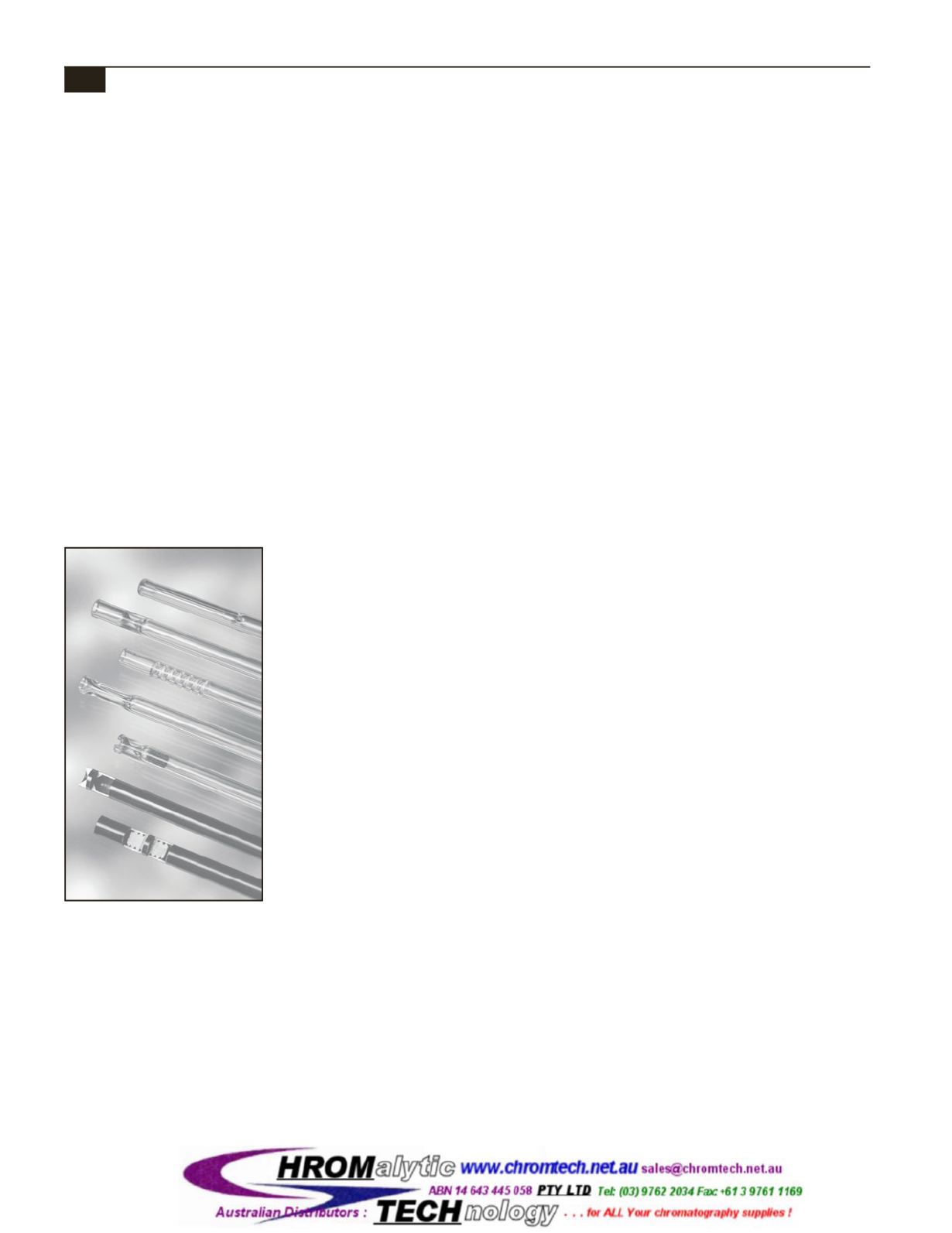
○
○
○
○
○
○
○
○
○
○
○
○
○
○
○
○
10
Injection Port Maintenance
The injection port is where a majority of analytical problems occur in the
analysis of pesticides. The main problem is the cleanliness and inertness of
the injection port with which the sample extract comes in contact. The two
compounds used to check the injection port inertness are endrin and 4,4'-
DDT. The breakdown components monitored for each compound are endrin
aldehyde and endrin ketone, and 4,4'-DDE and 4,4'-DDD, respectively.
The breakdown of 4,4'-DDT is generally indicative of a dirty injection port
caused by the analysis of oily or “dirty” sample extracts. Replacing the liner
and cutting6-12 inchesoff of theguard columnusually isneeded tobring the
system back to the original state. Sample extracts causing 4,4'-DDT break-
down usually need GPC or carbon column cleanup to separate the pesticide
from the samplematrix interferences.
Endrinbreakdown is usually indicative of a chemical reaction taking place in
the injectionport. Thebreakdown couldbe causedby impurities in the carrier
gas, activemetal surface, a non-deactivated liner or septa particles.
The carrier gas is usually the last troubleshooting area investigated and the
hardest to eliminate. Endrinmay react with a contaminate being carried into
the injection port by the carrier gas. Having gas scrubbers in-line for the
carrier gas will help keep this problem from occurring. In some instances, a
contaminate, such as argon, in the helium carrier gas has been found when
high endrinbreakdownhas occurred. To check for contaminatedhelium, use
a GC/mass spectrometer (MS). For example, scan for mass 40 to check for
argon contamination.
When the extract is injected into the hot injection port, the extract backflash
that escapes from the top and bottom of the liner comes into contact with
metal surfaces. Therefore, the metal surfaces of the injection port must be
kept clean, including the inlet carrier gas line. Periodic rinsing of the carrier
gas lines and swabbing out the injection port may be necessary if endrin or
4,4'-DDT breakdown increases over short periods of time or when only ana-
lyzing standards. Rinsing of the metal surfaces using solvents, or in some
cases silanizing the injection port, has helped. To solvent rinse, trace the
carrier gas line from the injectionport back to the first connection, rinse from
that point to the injection port with solvents using a syringe or HPLC pump.
Do not flush solvent through any actuator valves or rubber parts, and rinse
with injection port at room temperature.
Improperlydeactivated injectionport linerswill also cause endrinbreakdown.
The best way to avoid this problem is to replace the liner with anewly deacti-
vated liner when performing routinemaintenance. There are two approaches
to liner deactivation: perform the operation in-house or send liners out to be
deactivated. Sending injection port liners to a company like Restek for clean-
ing and deactivating is inexpensive and keeps analysts from spending time
chemically deactivating liners. There is a standard procedure for deactivating
liners that includes a process of cleaning the liners in acid and deactivating
withdichlorodimethylsilane. Call Restek’s technical service formore informa-
tion on this procedure.
Septa particles are a major cause of endrin breakdown. The septa particles
will sit on topof aglasswool plugor at thebottomof the liner.Generally, filing
down theburrs on the endof the syringeneedlewill help eliminate the coring.
Another approach is to try different septa that feature reduced coring. As
technologies change, new septa are investigated for their bleed characteris-
tics and softness at different temperatures. The latest technologies on septa
are available by requesting
A Guide to Minimizing Septa Problems
(lit. cat.#
59886).
The effects of chromatographic peak shape on linearity vary widely. In some
cases, as with endrin aldehyde on the cyanopropyl phases (i.e., 1701 phase),
○ ○ ○ ○ ○ ○ ○ ○ ○ ○ ○ ○ ○ ○ ○ ○ ○ ○ ○ ○ ○ ○ ○ ○ ○ ○ ○ ○ ○ ○ ○ ○ ○ ○ ○ ○ ○ ○ ○ ○ ○ ○
All Restek liners are
deactivated formaximum
inertness andminimumpesti-
cide breakdown. Order our
Inlet Supplies Catalog
(lit.
cat.#55980) for a
completeproduct listing.


